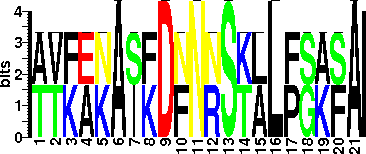

| Technique(s) used for Glycosylation Detection | Immunoblot analysis using glycosylation-specific R12 antiserum |
| Technique(s) used for Glycosylated Residue(s) Detection | Site-directed mutagenesis |
| Glycan Information |
| Glycan Annotation | Linkage: Bac-Asn.
1406 Da heptasaccharide composed of GalNAc-α1,4-GalNAc-α1,4-[Glcβ1,3-]GalNAc-α1,4-GalNAc-α1,4-GalNAc-α1,3-Bac-β1,N-Asn-Xaa, where Bac is bacillosamine, 2,4-diacetamido-2,4,6-trideoxyglucopyranose. |
| BCSDB ID | 23625 |
| GlyTouCan | G58528CE |
| Technique(s) used for Glycan Identification | 1H, 13C NMR spectroscopy- one dimensional TOCSY (total correlation spectroscopy) and NOESY (nuclear Overhauser effect spectroscopy); HMBC (heteronuclear multiple bond coherence), HMQC (heteronuclear multiple quantum correlation) spectra. |
| Protein Glycosylation linked (PGL) gene(s) |
| OST Gene Name | PglB |
| OST ProGT ID | ProGT10 |
| Characterized Accessory Gene(s) | PglA, PglJ, PglH, PglI, PglC are glycosyltransferases involved in the heptasaccharide assembly. PglFED are the bacillosamine biosynthetic enzymes. PglK is a flippase. |
| Accessory Gene(s)Progt ID | ProGT10.1, ProGT10.2, Pro |
| Additional Comment | AcrA is a native glycoprotein. However, its glycosylation was characterized in E. coli in which C. jejuni glycosylation machinery had been reconstituted.
Sequon feature: The consensus sequence for the C jejuni PglB is D/E-X'-N-X"-S/T (where X' and X" stand for any amino acid except proline) which is glycosylated when located in flexible, exposed structural elements. Tripeptide sequence NLT too has been found to be modified in vitro. |
| Literature |
| Year of Identification | 2002 |
| Year of Identification Month Wise | 2002.11.29 |
| Year of Validation | 2002 |
| Reference | Maita, N., Nyirenda, J., Igura, M., Kamishikiryo, J. and Kohda, D., 2010. Comparative Structural Biology of Eubacterial and Archaeal Oligosaccharyltransferases 2. Journal of Biological Chemistry, 285(7), pp.4941-4950. |
| Corresponding Author | Daisuke Kohda |
| Contact | Division of Structural Biology, Medical Institute of Bioregulation, Kyushu University, Maidashi 3-1-1, Higashi-ku, Fukuoka 812-8582, Japan. |
| Reference | Olivier, N.B., Chen, M.M., Behr, J.R. and Imperiali, B., 2006. In vitro biosynthesis of UDP-N, N ‘-diacetylbacillosamine by enzymes of the Campylobacter jejuni general protein glycosylation system. Biochemistry, 45(45), pp.13659-13669. |
| Corresponding Author | Barbara Imperiali |
| Contact | Department of Chemistry, Massachusetts Institute of Technology, 77 Massachusetts Avenue, Cambridge, Massachusetts 02139, USA. |
| Reference | Nita-Lazar, M., Wacker, M., Schegg, B., Amber, S. and Aebi, M., 2005. The NXS/T consensus sequence is required but not sufficient for bacterial N-linked protein glycosylation. Glycobiology, 15(4), pp.361-367. |
| Corresponding Author | Markus Aebi |
| Contact | Institute of Microbiology, Department of Biology, Swiss Federal Institute of Technology, Zürich, CH-8092 Zürich, Switzerland. |
| Reference | Wacker, M., Linton, D., Hitchen, P.G., Nita-Lazar, M., Haslam, S.M., North, S.J., Panico, M., Morris, H.R., Dell, A., Wren, B.W. et al. (2002) N-linked glycosylation in Campylobacter jejuni and its functional transfer into E. coli. Science, 298, 1790-1793. [PubMed: 12459590] |
| Corresponding Author | Markus Aebi |
| Contact | Institute of Microbiology, Department of Biology, Swiss Federal Institute of Technology, Zürich, CH-8092 Zürich, Switzerland. |
| Reference | Scott, N.E., Parker, B.L., Connolly, A.M., Paulech, J., Edwards, A.V., Crossett, B., Falconer, L., Kolarich, D., Djordjevic, S.P., Højrup, P. and Packer, N.H., 2011. Simultaneous glycan-peptide characterization using hydrophilic interaction chromatography and parallel fragmentation by CID, higher energy collisional dissociation, and electron transfer dissociation MS applied to the N-linked glycoproteome of Campylobacter jejuni. Molecular & cellular proteomics, 10(2), pp.S1-S18. |
| Corresponding Author | Stuart J Cordwell |
| Contact | School of Molecular and Microbial Biosciences, University of Sydney, Sydney, Australia |
| Reference | Kowarik, M., Young, N.M., Numao, S., Schulz, B.L., Hug, I., Callewaert, N., Mills, D.C., Watson, D.C., Hernandez, M., Kelly, J.F. and Wacker, M., 2006. Definition of the bacterial N‐glycosylation site consensus sequence. The EMBO journal, 25(9), pp.1957-1966. |
| Corresponding Author | Markus Aebi |
| Contact | Institute of Microbiology, Department of Biology, Swiss Federal Institute of Technology, Zürich, CH-8092 Zürich, Switzerland. |